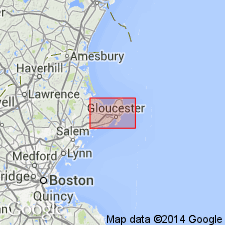
- Usage in publication:
-
- Cape Ann granite*
- Modifications:
-
- First used
- Dominant lithology:
-
- Granite
- Syenite
- AAPG geologic province:
-
- New England province
Summary:
The bedrock on Cape Ann is mainly granite cut in various directions with diabase and other dikes. Different geologists have called it syenite, granite, and granitite. Besides essential minerals, there is plagioclase, magnetite, limonite, chlorite, apatite, zircon, epidote, and fluorite. The granite varies in its texture and composition.
Source: GNU records (USGS DDS-6; Reston GNULEX).
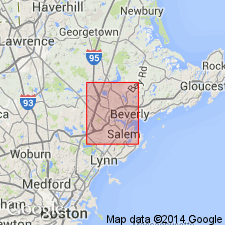
- Usage in publication:
-
- Cape Ann Granite*
- Modifications:
-
- Overview
- AAPG geologic province:
-
- New England province
Summary:
The name Cape Ann Granite is used in this report for a map unit comprising the granites exposed on the island of Cape Ann and thence westward and southwestward into the towns of Ipswich, Danvers, and Beverly. The granites of the "alkalic" group have generally been mapped under the name Quincy Granite because of their probable correlation with the granites at Quincy, MA. The petrographic similarities between the granites of Essex Co. (includes the Cape Ann) and the Quincy Granite are much more striking than their differences, and the general correlation of the two groups seems justified. On the other hand, their differences are sufficient to distinguish them, and the two areas of outcrop are 20 miles apart. For these reasons, the name Quincy Granite is not applied to the granites of Essex Co. in this report. The names Peabody Granite and Cape Ann Granite were originally proposed by Clapp, 1910 (The igneous rocks of Essex Co., MA; Abstract of thesis, Massachusetts Inst. Tech., 12 p.). For many years the Peabody and Cape Ann Granites have been mapped under the name Quincy Granite, but as the two units are petrographically distinguishable and occur in separate intrusive bodies, the names Peabody and Cape Ann are here revived.
Source: GNU records (USGS DDS-6; Reston GNULEX).
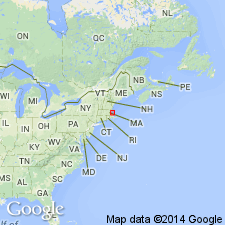
- Usage in publication:
-
- Cape Ann Granite*
- Modifications:
-
- Age modified
- Geochronologic dating
- AAPG geologic province:
-
- New England province
Summary:
A radiometric age of 450 Ma was derived from a concordia plot of U-Pb analyses of zircons from granite of the Cape Ann Granite; it was considered of Late Ordovician age. A possibility exists, however, that because of the analytical uncertainty all or part of the complex might be of Early Silurian age. The Cape Ann, therefore, is considered to be of Late Ordovician or Early Silurian age.
Source: GNU records (USGS DDS-6; Reston GNULEX).
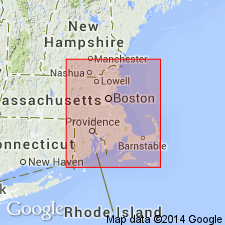
- Usage in publication:
-
- Cape Ann Complex*
- Modifications:
-
- Revised
- AAPG geologic province:
-
- New England province
Summary:
Alkalic plutonic rocks comprising the Cape Ann pluton formerly called the Cape Ann Granite is revised to the Cape Ann Complex. The complex is comprised of an unnamed alkalic granite and quartz syenite unit, the Beverly Syenite, and the Squam Granite.
Source: GNU records (USGS DDS-6; Reston GNULEX).

- Usage in publication:
-
- Cape Ann Complex*
- Modifications:
-
- Overview
- AAPG geologic province:
-
- New England province
Summary:
Used as Cape Ann Complex of Late Ordovician or Early Silurian age. Consists of alkalic granite to quartz syenite containing ferrohornblende. Intrudes unnamed Late Proterozoic diorite and gabbro. Includes Beverly Syenite (a quartz-poor facies) and Squam Granite (a fine- to medium-grained monzodiorite).
Source: GNU records (USGS DDS-6; Reston GNULEX).
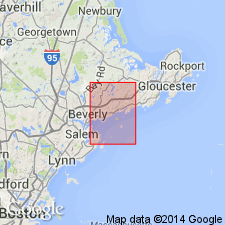
- Usage in publication:
-
- Cape Ann Granite*
- Modifications:
-
- Revised
- AAPG geologic province:
-
- New England province
Summary:
Cape Ann Complex of Goldsmith and others (1982) and used on the Massachusetts State Geologic Map (Zen and others, 1983) is revised and renamed the Cape Ann Granite. The name is changed primarily because this rock assemblage does not fit the definition of a complex as defined in the North American Stratigraphic Code (1983). The new definition includes the original Cape Ann Granite (Toulmin, 1964) and the Beverly Syenite of Washington (1898, 1899) and Clapp (1910). The use of Cape Ann Complex, which includes the original Cape Ann Granite, the Squam Granite of Clapp (1910), and the Beverly Syenite, is discontinued. The Beverly Syenite is considered a facies of the Cape Ann Granite and effectively abandoned as a formal unit. Age is given as Ordovician.
Source: GNU records (USGS DDS-6; Reston GNULEX).
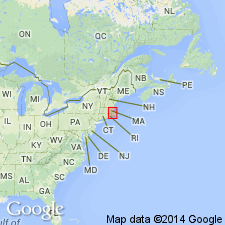
- Usage in publication:
-
- Cape Ann Complex*
- Modifications:
-
- Revised
- Geochronologic dating
- AAPG geologic province:
-
- New England province
Summary:
Most of Cape Ann Complex forms Cape Ann peninsula of northeastern MA. Consists of alkalic granite to quartz syenite (its main phase), Beverly Syenite, and Squam Granite, all of which form a pluton covering 385 sq km. Intrudes Late Proterozoic greenschist, diorite, and gabbro that earlier workers assigned to Marlboro Formation, Salem Gabbro-Diorite, or Middlesex Fells Volcanic Complex. Dennen (1975) considered masses of diorite and gabbro within and adjacent to Cape Ann Complex to be cogenetic with it and equivalent in age to Nahant Gabbro and gabbro at Salem Neck. Authors recommend that usage of term Salem Gabbro-Diorite be restricted to these masses of diorite and gabbro in and around Cape Ann pluton that are younger than Dedham Granite and cogenetic with Cape Ann Complex. Gabbro at Salem Neck is probably representative. Radiometric ages straddle Late Ordovician-Early Silurian boundary. Age is based on Rb-Sr whole rock isochron of 426 +/-6 Ma (Zartman and Marvin, 1971) and U-Pb zircon date of 450 +/-25 Ma (Zartman, 1977). [Papers presented as chapters in U.S. Geological Survey Professional Paper 1366 are intended as explanations and (or) revisions to MA State bedrock geologic map of Zen and others (1983) at scale of 1:250,000.]
Source: GNU records (USGS DDS-6; Reston GNULEX).
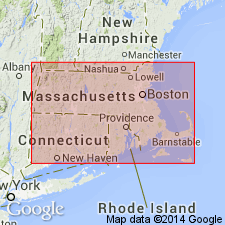
- Usage in publication:
-
- Cape Ann Complex
- Modifications:
-
- Overview
- AAPG geologic province:
-
- New England province
Summary:
Cape Ann Complex consists of several lithological types of which the Cape Ann Granite and the Beverly Syenite are the most dominant. The Squam Granite, smaller but distinct, may not be genetically related. The origin of the granitic melt, except for the Squam, was likely under water-deficient conditions. The origin of the Squam remains obscure.
Source: GNU records (USGS DDS-6; Reston GNULEX).
For more information, please contact Nancy Stamm, Geologic Names Committee Secretary.
Asterisk (*) indicates published by U.S. Geological Survey authors.
"No current usage" (†) implies that a name has been abandoned or has fallen into disuse. Former usage and, if known, replacement name given in parentheses ( ).
Slash (/) indicates name conflicts with nomenclatural guidelines (CSN, 1933; ACSN, 1961, 1970; NACSN, 1983, 2005, 2021). May be explained within brackets ([ ]).

